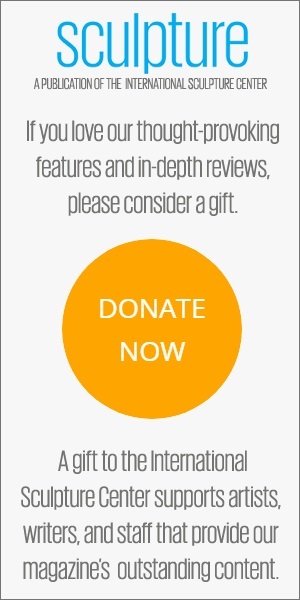Chicago DePaul Art Museum Advertisements tell people what to think, what to buy, and how to act. But not Matt Siber’s “Idol Structures.” The Chicago-based artist’s photographs and large-scale sculptures encouraged viewers to consider the structures of mass media communication and advertisements found in public spaces.
Robert Irwin
BEACON, NEW YORK Dia:Beacon Robert Irwin’s “site-conditioned” installation Excursus: Homage to the Square3 is a navigable optical illusion of 18 interconnected rooms divided by floor-to-ceiling semi-transparent scrims. Originally commissioned by Dia Center for the Arts for its former space in Chelsea in 1998, the new iteration engages with the architectural and lighting specificities of its redesigned space in Beacon. Taking cues from his surroundings, Irwin manipulates the existing building to form a Gesamtkunstwerk out of an old box factory turned museum.
Samara Golden
NEW YORK MoMA PS1 A display of silver Escher-inspired stairs leading nowhere, some absurdly upside down, some supporting tensely poised silver wheelchairs (wheels both down and up), burst like a hallucination upon visitors to PS1. Without exception, gallery-goers whipped out their cell phones, because no one could be sure that their dazzled faculties of perception would retain the scene without a photo. Samara Golden’s The Flat Side of the Knife (2014–15) conjured a witty, dream-like atmosphere that toyed with the subconscious while tweaking our certainty about what we think we see.
Teppei Kaneuji
NEW YORK Jane Lombard Gallery Entering the world of Tokyo-based sculptor Teppei Kaneuji is like walking into a funky workshop gone awry. Quirky combinations of tools, surreal arrangements of household objects on barbecue grills, towers of Claes Oldenburg knock-offs, and black and white stuffed toys collide to create a phantasmagoria of color and action.
Choong Sup Lim
NEW YORK Korea Society Choong Sup Lim is a highly accomplished Korean-born artist who has lived and worked in New York since 1973. His work offers a marked contrast to the notion of materialism so rampantly displayed in the so-called art fairs that have displaced the spiritual concept in art, a concept that Lim understands as indigenous to the culture of his homeland. Luna—Thousand Rivers & Thousand Reflections (2015), a room-size installation, consists of traditional Korean cotton thread (1,000 yards), rice paper (hanji), wax, wood, a kinetic system to move the thread, and a DVD projection.
James Siena
NEW YORK Pace Gallery James Siena’s extensive show of large and small, intricate sculptures in wood and metal seemed very much like an essay in structure. In an interview with Julia Schwartz for Figure/Ground, Siena acknowledged the influence of open-wire works of art: “I met Alan Saret early in my years in New York and was tremendously moved by his light-permeable wire sculptures.” While the range of sculpture in Siena’s exhibition was broad, both in size and materials (bronze, cherry wood, bamboo), the fabrication process was close to identical: sticks are attached to the ends of other sticks, the connections building an open design in which light and space are as important as the construction itself.
Christopher Wool
NEW YORK Luhring Augustine Christopher Wool’s 2013 show at the Guggenheim Museum didn’t seem terribly convincing. It is likely that many viewers found the paintings uninspired and stylistically repetitive. But his sculptures, which mostly consist of curved, bronze tubular lines, look more interesting. Wool’s three-dimensional works reference New York School painting as much as they consider the current state of American sculpture. Still, his work has to justify itself on a contemporary basis rather than an archival one.
Susan Fitzsimmons
EDINBURG, TEXAS Dorothy Charles Clark Gallery “Sentinels and Guardians,” an exhibition of bronze sculptures by Susan Fitzsimmons at the Clark Gallery of the University of Texas in Edinburg (where Fitzsimmons is a professor and chair of the art department), presented an engaging paradox. Bronze casting is a highly skilled as well as physically demanding discipline and requires careful planning. Traditionally, hot molten bronze is poured into a wax-filled mold, then packed in sand as it cools and solidifies. In the process, the wax is burned out, revealing the form.
Leo Saul Berk
SEATTLE Frye Art Museum Leo Saul Berk’s recent exhibition “Structure and Ornament” featured a series of sculptural installations commissioned by the Frye Art Museum and Frye Foundation. In an unusually apt interface between an artist and the museum’s permanent collection of 19th-century German art, director Jo-Anne Birnie Danzker linked Berk’s variations on his childhood home (eccentric architect Bruce Goff’s Ford House in Aurora, Illinois) to the Frye’s substantial holdings of the multi-disciplinary Munich Secession.
Rita Simoni
BUENOS AIRES Zafarrancho I have been following the work of the Argentine artist Rita Simoni for many years, and I must confess that it still surprises me. Her work offers a clear example of a skill that can’t be ignored by contemporary artists—the ability to adapt to a specific environment using as many stylistic devices and supports as needed. Architect, photographer, visual artist, Simoni can move from the two-dimensional to installation, from an artist’s book to 3D digital design; there are no limits for her. Humectaria took place in an unconventional, almost unthinkable, and even hostile space.







